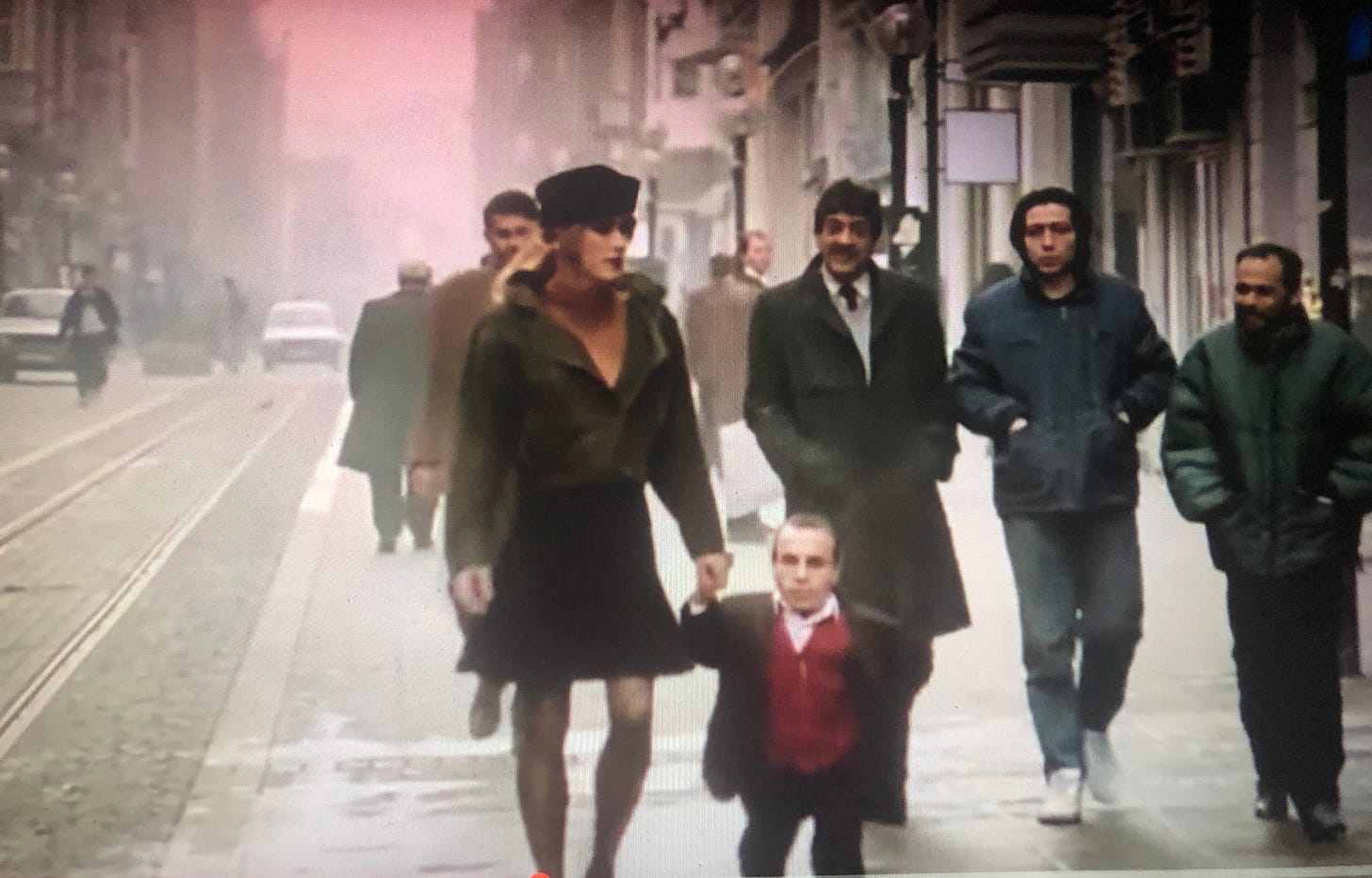All Eyes on Istanbul Film Series #2: Dönersen Islık Çal
This brave and touching 1992 film about the bond formed between a dwarf bartender and a trans sex worker is set in the backdrop of an eerie Beyoğlu at night.
Among my favorite Turkish films, Dönersen Islık Çal (Whistle If You Come Back) is arguably one of the most important and beloved productions of Turkish cinema from the 1990’s. It stars Fikret Kuşkan in an excellent performance as an trans sex worker, who develops a friendship with a dwarf bartender played by Mevlüt Demiryay, whose acting is equally top-notch. Early on the film, we see the woman alongside a number of other trans and queer people being literally “kicked out of the city” by police who rounded them up and dropped them off in the middle of nowhere. This was a common policy at the time. We don’t learn the names of any of the few characters in the film. The woman is chased through the backstreets of Beyoğlu at night by three hooligans who eventually catch her, cut her wig and beat her up until the bartender blows a whistle from around the corner, prompting the men to flee. The bartender takes the woman into his home and prepares a warm meal. He is initially quite taken with her and tells her that she is beautiful, only to change his tone when he hears her voice and sees her without her wig on:
“You’re not a woman. You tricked me. Thinking about it makes me sick to my stomach. You’re very ugly,” he says.
Unfazed, the woman approaches the bartender and says “Ayyyy look at the person calling me ugly. You probably never look at the mirror. Am the I ugly one or is it you?” He orders her to leave, but after she tells him that at this hour of the night returning to the streets would be lethal, and he says she can stay into the morning. The bartender retreats to his balcony, which overlooks Istiklal Avenue and where he sits alone most nights after work. He pours himself a glass of rakı and strokes one of the puppies that he takes care of. When the woman comes out and sees him drinking, she is impressed. “You’re a fun guy!” she says, insisting they have a drink together. He quickly warms up to her, raising his glass and saying “sağlına” (to your health). She says that’s not how to do it, and approaches him, clinks his glass and says “cam cama, can cana” (glass to glass, soul to soul) in what is one of the many heartwarming moments in the film.
She subsequently notices his whistle, which from the beginning is an integral part of the film and the source of its title. She realizes that it was him who blew the whistle causing the thugs that beat her up to run away, and says he is a genius. He tells her that the whistle protects him at night from the dangers of the rough Beyoğlu streets. While she is a target for her identity, he is a target for his stature at under three feet tall. Their blooming friendship emerges as they share a common understanding as marginalized people shunned by society and subjected to discrimination and violence. Though they make fun of each other, they quickly develop a bond based on respect and solidarity that they could not find in others.

After a murder that the woman witnesses, she demands money from the bartender so she can flee town for awhile in order to avoid police interrogation. He gives her all the money he has in his pocket, but she thinks he is lying and has more hidden away. This results in a souring of the friendship, and the film (no spoilers) takes an increasingly tragic route. Dönersen Islık Çal is a tearjerker, but ends with a literal sense of color not seen throughout the film. In addition to wonderfully depicting the complexities of a strange yet ultimately logical friendship, the film also showcases a Beyoğlu in the early 1990’s where İstiklal Avenue had just been pedestrianized. Though this drastically transformed the area in the ensuing years, the Beyoğlu of the film is still dodgy and male-dominated, its streets run by pimps, drug dealers and swindlers. Though most of the film takes place at night, there are beautiful scenes of the street during the daytime when the area is relatively safer though still poses a constant threat to our heroes.
Note: For those who want to watch the film, there are two versions on YouTube. The complete version is of poor quality, while the restored version is gorgeous but for some reason cuts out the opening and closing scenes. For that reason, I would recommend starting with the and ending with the complete version while watching the bulk of the film in its restored state.






Thanks for reminding us of this beautiful but forgotten art